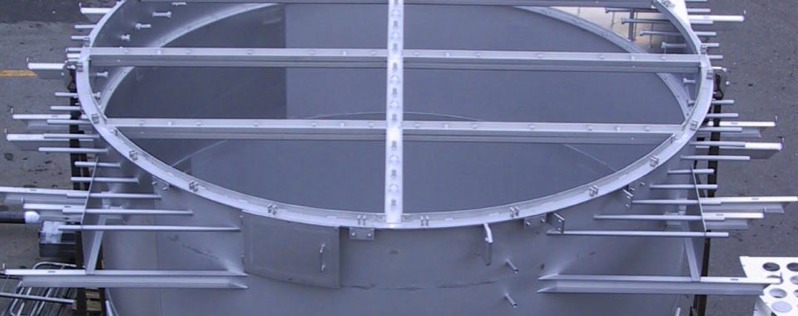
Fabricators
Pickling & Passivation Products for U. S. Metal Fabricators from QWP
For metal fabricators working with 300-series Stainless Steel, Nickel, Titanium, and Aluminum alloys, customer specifications for completed fabrications can usually include a requirement for pickling & passivation of the fabricated items. Typically, fabricators ship completed items to a metal finishing firm for the required surface treatment to meet those requirements. In many cases, however, pickling & passivation can be done by the fabricator, using Antox products supplied by Quality Welding Products, Inc. For most fabricators, making the decision to perform some or all pickling & passivation in-house requires analysis of potential benefits and issues.
Time Saved through In-House Pickling & Passivation Is a Major Benefit
Shipping fabricated items to a metal finishing company for pickling & passivation always involves time and additional costs. That time varies, of course, but tight schedules and time constraints in filling customer orders, along with metal finishing company’s schedule, can create problems for many fabricators. If pickling & passivation is done where the fabrication takes place, those time issues and potential delays disappear. In some cases, especially with large or bulky items, shipping to a metal finisher can be very costly or even completely impractical.
Pickling & passivation of welded seams and surrounding areas with Antox Pickling Paste products from QWP can be completed quickly and efficiently. Ambient temperature pickling bath treatments for smaller items, using Antox Bath Pickling products, allows fabricators to meet passivation requirements for multiple items efficiently without shipping. For large fabrications, QWP markets Spray Pickling products from Antox that let you avoid shipping oversized projects to metal finishers.
For metal fabricators working with 300-series Stainless Steel, Nickel, Titanium, and Aluminum alloys, customer specifications for completed fabrications can usually include a requirement for pickling & passivation of the fabricated items. Typically, fabricators ship completed items to a metal finishing firm for the required surface treatment to meet those requirements. In many cases, however, pickling & passivation can be done by the fabricator, using Antox products supplied by Quality Welding Products, Inc. For most fabricators, making the decision to perform some or all pickling & passivation in-house requires analysis of potential benefits and issues.
Time Saved through In-House Pickling & Passivation Is a Major Benefit
Shipping fabricated items to a metal finishing company for pickling & passivation always involves time and additional costs. That time varies, of course, but tight schedules and time constraints in filling customer orders, along with metal finishing company’s schedule, can create problems for many fabricators. If pickling & passivation is done where the fabrication takes place, those time issues and potential delays disappear. In some cases, especially with large or bulky items, shipping to a metal finisher can be very costly or even completely impractical.
Pickling & passivation of welded seams and surrounding areas with Antox Pickling Paste products from QWP can be completed quickly and efficiently. Ambient temperature pickling bath treatments for smaller items, using Antox Bath Pickling products, allows fabricators to meet passivation requirements for multiple items efficiently without shipping. For large fabrications, QWP markets Spray Pickling products from Antox that let you avoid shipping oversized projects to metal finishers.
Safety Concerns Are Easily Overcome for Pickling & Passivation Operations
Many fabricators are concerned with worker safety issues when they consider adding pickling & passivation processes to their operations. Safety is important, but a relatively small investment in safety equipment for employees, worker training, and careful adherence to the safety precautions detailed in the individual products’ MSDS and Product Data Sheets allows fabricators to use ANTOX pickling & passivation products safely and effectively.
Disposal of Pickling Residues Can Be Effectively Managed
As the MSDS and Product Data Sheets for Antox pickling products make clear, pickling residues and rinse water must be collected and disposed of as hazardous waste. They cannot be washed down a drain or dumped into the sewer system. This is a major concern for most fabricators and hazardous waste disposal comes at a cost. In most areas of the United States, hazardous waste disposal services are available through major waste disposal contractors who will pick up your waste, transport it, and process it correctly. A consultation with one of these contractors can help you plan for these needs and estimate disposal costs.
Is In-House Pickling & Passivation the Right Choice?
Every fabricator considering using Antox Pickling & passivation products from QWP should evaluate pickling & passivation needs carefully. Weigh time saved and processing costs from shipping to metal finishers against safety and disposal requirements and costs. Explore the available Antox products on this website and review the MSDS and Product Data Sheets for the products you’re considering. Then, Contact QWP for additional information and recommendations and to order top-quality Antox products if handling all or some of your pickling & passivation needs is a good solution for your business.